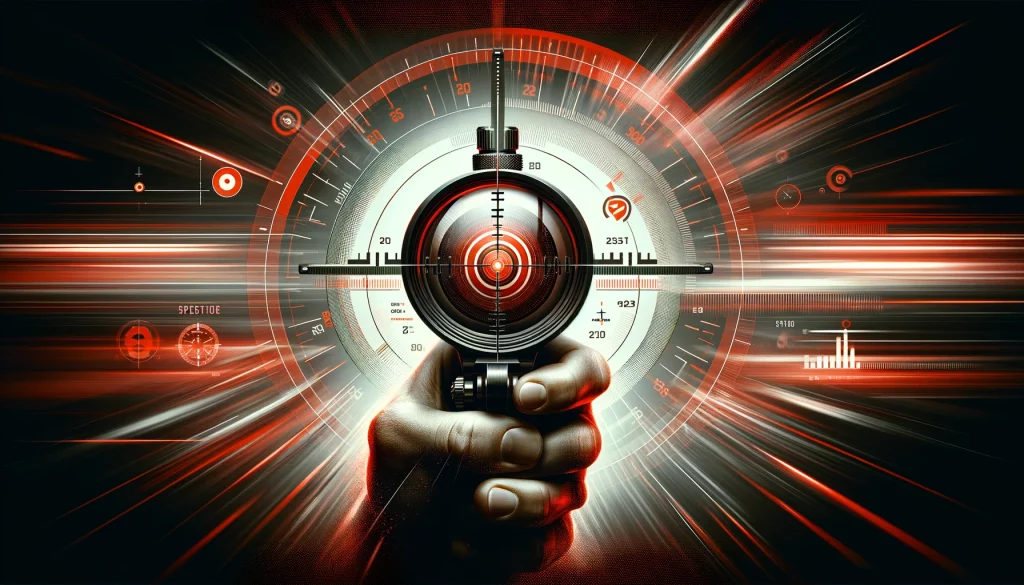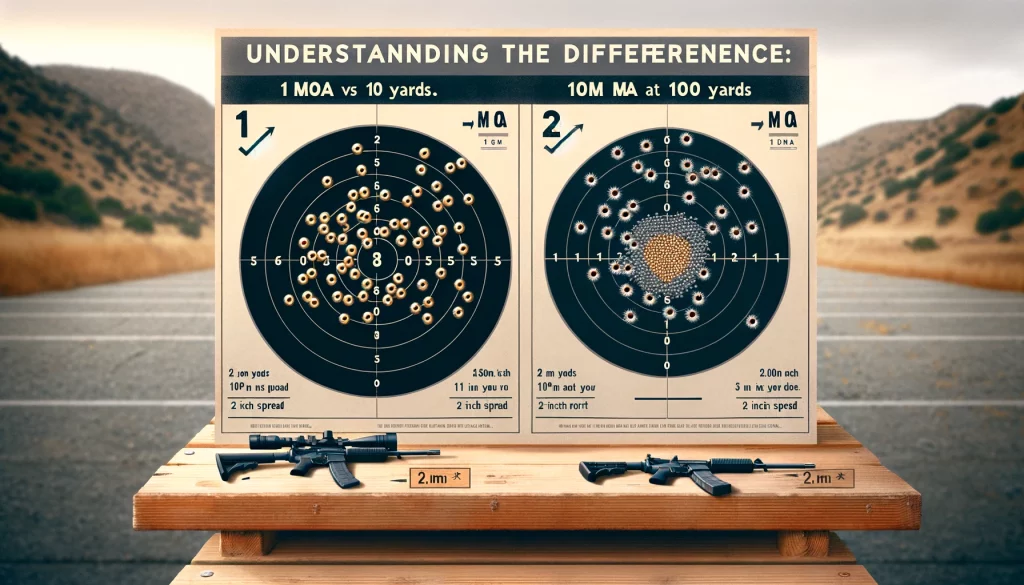In the world of firearms and shooting, precision is paramount. Whether it’s for hunting, competitive shooting, or self-defense, the accuracy of your shots can be significantly influenced by the equipment you choose.
Among the various factors that contribute to shooting accuracy, the choice of red dot size, measured in MOA (Minute Of Angle), is crucial. MOA is a unit of angular measurement used to describe the accuracy and size of the reticle on red dot sights.
The debate between 1 MOA vs 2 MOA dots is a common one among shooters, as each has its benefits and drawbacks depending on the shooting application. This article aims to dissect the differences between 1 MOA and 2 MOA red dot sights, helping shooters understand which size might best suit their needs for different shooting activities.
Understanding MOA
MOA stands for Minute Of Angle, a term that originated from the field of angular measurements and has become integral to the shooting community for describing accuracy and sight precision.
One MOA is equal to 1/60th of a degree, which translates to approximately 1.047 inches at 100 yards, though it is often rounded down to 1 inch for simplicity. This means if a rifle is said to have a 1 MOA accuracy, it can make a group of shots within a 1-inch circle at 100 yards under ideal conditions.
When it comes to red dot sights, the MOA size refers to the diameter of the dot that the shooter sees when looking through the sight. A 1 MOA dot will cover 1 inch of the target at 100 yards, whereas a 2 MOA dot will cover 2 inches of the target at the same distance.
The choice between 1 MOA and 2 MOA dots is significant because it affects how precisely a shooter can aim at the target. A smaller MOA dot offers more precision, making it suitable for long-distance shooting where accuracy is critical.
In contrast, a larger MOA dot is easier to see and faster to acquire, advantageous in close-range shooting scenarios where speed is of the essence.
Precision Shooting
When delving into the realm of long-range accuracy, the distinction between a 1 MOA and a 2 MOA dot becomes notably significant. The finer point of a 1 MOA dot offers minimal obstruction on the target, allowing for more precise aim and shot placement.
This level of detail is crucial for scenarios demanding high accuracy, such as hitting small targets at considerable distances. The smaller dot size ensures that the shooter can see more of the target, making it easier to adjust aim with greater precision.
For enthusiasts and professionals who prioritize exactness in their shots, especially over longer ranges, the 1 MOA dot provides an edge in enhancing shooting accuracy.

Target Acquisition Speed
On the flip side, the speed at which a shooter can acquire a target plays a pivotal role in dynamic shooting scenarios or when engaging in close-quarters combat. Here, the visibility of a 2 MOA dot becomes its greatest asset.
Its larger size makes it more conspicuous against various backgrounds, facilitating quicker sighting. This attribute is particularly beneficial in fast-paced environments where reaction time is critical.
The ability to quickly locate and align the dot with the target streamlines the shooting process, making a 2 MOA dot an ideal choice for situations that demand rapid target engagement.
Balancing the need for speed with the requirement for accuracy is key, with the 2 MOA dot offering a practical solution for those valuing swift, efficient target acquisition.

Read More: Benelli Ethos Vs Beretta A400
Self-Defense Considerations
In self-defense scenarios, the ability to quickly and effectively neutralize a threat is paramount. Here, the choice between a 1 MOA and a 2 MOA red dot sight can have significant implications.
The larger, more visible 2 MOA dot is often more advantageous in such situations due to its enhanced visibility, which can be crucial in high-stress environments where rapid target acquisition is essential.
The immediate recognition of the aiming point allows for faster response times, making it easier for defenders to align their sights on a target under pressure.

Use in Different Ranges
The performance of 1 MOA and 2 MOA dots varies across different distances. At close range, the 2 MOA dot’s visibility offers quick target engagement, a crucial advantage in rapid-response scenarios.
As distance increases, the precision of a 1 MOA dot becomes more valuable, allowing for accurate shot placement at longer ranges without obscuring the target.
This differentiation highlights the importance of selecting a dot size based on anticipated shooting distances, with 1 MOA dots favoring accuracy at extended ranges and 2 MOA dots supporting faster sighting at closer distances.
Compatibility with Magnifiers and Other Accessories
Both 1 MOA and 2 MOA red dot sights interact differently with magnifiers and optical accessories. A 1 MOA dot, when magnified, retains its precise aiming capability, making it suitable for detailed long-range shots.
Conversely, a 2 MOA dot becomes larger under magnification, which may affect precision but remains useful for mid-range targets where quick identification remains a priority.
This interplay between dot size and accessories underscores the need to consider how each dot will function with additional equipment, ensuring that the chosen setup aligns with the shooter’s needs.
User Preference and Versatility
Ultimately, the decision between a 1 MOA and 2 MOA dot often comes down to personal preference and the versatility required by the shooter. Some may prefer the precise aiming offered by a 1 MOA dot for specific disciplines, while others may favour the quicker sighting possible with a 2 MOA dot for varied scenarios.
The versatility of a red dot sight in accommodating different shooting styles and situations plays a significant role in this choice.
Shooters should weigh their specific needs, preferences, and the types of shooting they most frequently engage in when selecting their optimal dot size.
Case Studies and User Feedback
Real-world experiences and feedback from shooters can provide valuable insights into the practical application of 1 MOA and 2 MOA red dot sights. By examining case studies and user feedback, we can gain a deeper understanding of how these different dot sizes perform in various shooting scenarios.
Shooters’ firsthand accounts of their experiences with both types of sights offer valuable perspectives on factors such as accuracy, target acquisition speed, and overall satisfaction with their chosen red dot sight.
Comparisons Table: “1 MOA vs 2 MOA”
| Feature | 1 MOA | 2 MOA |
| Definition | Minute of Angle, a unit for angular measurement equal to 1/60th of a degree. At 100 yards, 1 MOA approximates to 1 inch. | Same as 1 MOA, but 2 MOA approximates to 2 inches at 100 yards. |
| Precision | Offers higher precision, suitable for long-range shooting where accuracy is critical. | Slightly less precise, but still effective for various shooting applications. |
| Visibility | Smaller reticle dot or crosshair size, which might be harder to see against complex backgrounds or at longer distances. | Larger reticle dot or crosshair size, offering better visibility, especially in low-light conditions or against busy backgrounds. |
| Application | Preferred by long-range target shooters and hunters needing to make precise shots at greater distances. | Often favored for close to mid-range engagements, including hunting and tactical scenarios where speed is prioritized over pinpoint accuracy. |
| Adjustment Sensitivity | Finer adjustment capability, allowing for more detailed zeroing and compensation for bullet drop and wind drift. | Broader adjustments with each click, making it quicker to adjust but with less granularity than 1 MOA adjustments. |
| Target Size | Better suited for smaller targets where minimizing the margin of error is essential. | More suitable for larger targets where the broader visibility of the reticle aids in faster target acquisition. |

Frequently Asked Questions (FAQs)
What is MOA, and why does it matter in red dot sights?
MOA, or Minute Of Angle, is a unit of angular measurement that describes the size of the aiming point in a red dot sight. It matters because it affects the precision and accuracy of the sight’s aiming point.
How does a 1 MOA dot differ from a 2 MOA dot in terms of accuracy?
A 1 MOA dot is smaller and offers finer aiming precision, making it ideal for long-range shooting where accuracy is crucial. In contrast, a 2 MOA dot is larger and provides quicker target acquisition, making it suitable for close to mid-range engagements.
Can I use a magnifier with both 1 MOA and 2 MOA red dot sights?
Yes, both dot sizes are compatible with magnifiers. However, the effect of magnification differs between the two. A 1 MOA dot retains its precision under magnification, while a 2 MOA dot becomes larger, potentially affecting accuracy.
Which dot size is better for self-defense situations?
In self-defense scenarios where speed is critical, a 2 MOA dot is often preferred due to its larger size, which facilitates quicker target acquisition. However, personal preference and shooting proficiency also play significant roles in determining the optimal dot size.
Are there any trade-offs to consider when choosing between 1 MOA and 2 MOA red dot sights?
Yes, there are trade-offs to consider. While a 1 MOA dot offers superior precision, it may be harder to see, especially in low-light conditions. On the other hand, a 2 MOA dot provides faster target acquisition but sacrifices some precision, particularly at longer ranges.
Conclusion
In conclusion, the debate between 1 MOA and 2 MOA red dot sights underscores the importance of considering multiple factors when selecting optics for shooting applications.
While both dot sizes offer distinct advantages, such as precision and speed, their suitability depends on individual shooting preferences, intended use cases, and environmental factors.
Whether prioritizing pinpoint accuracy for long-range shooting or rapid target acquisition for close-quarters combat, shooters must carefully evaluate their needs to determine the optimal dot size for their red dot sight.
